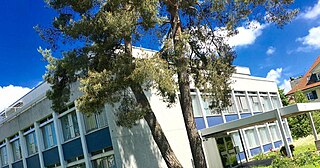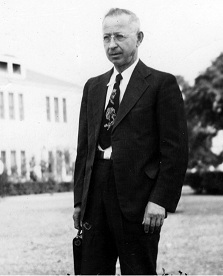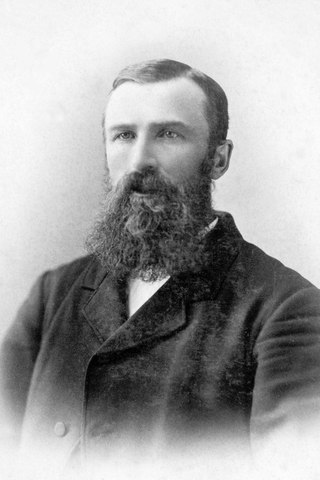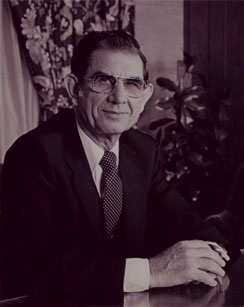
The Seventh-day Adventist Church (SDA) is an Adventist Protestant Christian denomination which is distinguished by its observance of Saturday, the seventh day of the week in the Christian (Gregorian) and the Hebrew calendar, as the Sabbath, its emphasis on the imminent Second Coming (advent) of Jesus Christ, and its annihilationist soteriology. The denomination grew out of the Millerite movement in the United States during the mid-19th century and it was formally established in 1863. Among its co-founders was Ellen G. White, whose extensive writings are still held in high regard by the church.

The Seventh Day Adventist Reform Movement is a Protestant Christian denomination in the Sabbatarian Adventist movement that formed from a schism in the European Seventh-day Adventist Church during World War I over the position its European church leaders took on Sabbath observance and on committing Adventists to the bearing of arms in military service for Imperial Germany in World War I.

The North American Division (NAD) of Seventh-day Adventists is a sub-entity of the General Conference of Seventh-day Adventists, which oversees the Church's work in the United States, Canada, French possessions of St. Pierre and Miquelon, the British overseas territory of Bermuda, the US territories in the Pacific of Guam, Wake Island, Northern Mariana Islands, and three states in free association with the United States - Palau, the Marshall Islands, and the Federated States of Micronesia. Founded in 1913, its headquarters in the same building as the General Conference, moved to separate quarters in Columbia, Maryland in 2017. As of June 30, 2021, the Division's membership was 1,267,711.

The Inter-European Division (EUD) of Seventh-day Adventists is a sub-entity of the General Conference of Seventh-day Adventists, which oversees the Church's work in a portions of Europe, which include the nations of Andorra, Austria, Belgium, the Czech Republic, France, Germany, Gibraltar, Italy, Liechtenstein, Luxembourg, Malta, Monaco, Portugal, Romania, San Marino, Slovakia, Spain and Switzerland. Its headquarters is in Bern, Switzerland.

The Adventist Development and Relief Agency International is a humanitarian agency operated by the Seventh-day Adventist Church for the purpose of providing individual and community development and disaster relief. It was founded in 1956, and it is headquartered in Silver Spring, Maryland, United States.
The International Religious Liberty Association (IRLA) is a non-sectarian and non-political organization promoting religious freedom. It was originally organized by the Seventh-day Adventist Church leaders in 1893 to campaign for religious freedom for all when the danger of restrictions from blue laws became apparent. Its headquarters are in Silver Spring, Maryland in the United States.

The Seventh-day Adventist Church had its roots in the Millerite movement of the 1830s to the 1840s, during the period of the Second Great Awakening, and was officially founded in 1863. Prominent figures in the early church included Hiram Edson, Ellen G. White, her husband James Springer White, Joseph Bates, and J. N. Andrews. Over the ensuing decades the church expanded from its original base in New England to become an international organization. Significant developments such the reviews initiated by evangelicals Donald Barnhouse and Walter Martin, in the 20th century led to its recognition as a Christian denomination.

The Shepherd's Rod or The Rod or the Davidians is an American offshoot of the worldwide Seventh-day Adventist Church. It was founded in 1929 by Victor Houteff, its President and Prophet. Houteff joined the Seventh-day Adventist church in 1919. He was excommunicated from the church in 1930 for promoting "heretical" doctrines.
The theology of the Seventh-day Adventist Church resembles that of Protestant Christianity, combining elements from Lutheran, Wesleyan-Arminian, and Anabaptist branches of Protestantism. Adventists believe in the infallibility of the Scripture's teaching regarding salvation, which comes from grace through faith in Jesus Christ. The 28 fundamental beliefs constitute the church's current doctrinal positions, but they are revisable under the guidance of the Holy Spirit, and are not a creed.
The Seventh-day Adventist baptismal vow is a list of 13 belief statements which a person joining the Seventh-day Adventist Church is given and accepts at believer's baptism. In Adventist understanding, baptism, is associated with officially joining the Adventist church, which is a part of the community of believers in Christ. The vow is explained in the church manual. In 2005 an alternate vow consisting of three statements was approved at the General Conference Session, and the baptizing pastor now has a choice of which set to use. They complement the 28 Fundamentals.
The General Conference Session is the official world meeting of the General Conference of Seventh-day Adventists, held every five years. At the session, delegates from around the world elect the Church's World Leaders, discuss and vote on changes to the Church's Constitution, and listen to reports from the Church's 13 Divisions on activities going on within its territory.
The 1888 Minneapolis General Conference Session was a meeting of the General Conference of Seventh-day Adventists held in Minneapolis, Minnesota, in October 1888. It is regarded as a landmark event in the history of the Seventh-day Adventist Church. Key participants were Alonzo T. Jones and Ellet J. Waggoner, who presented a message on justification supported by Ellen G. White, but resisted by leaders such as G. I. Butler, Uriah Smith and others. The session discussed crucial theological issues such as the meaning of "righteousness by faith", the nature of the Godhead, the relationship between law and grace, and Justification and its relationship to Sanctification.
Historic Adventism is an informal designation for conservative individuals and organizations affiliated with the Seventh-day Adventist Church who seek to preserve certain traditional beliefs and practices of the church. They feel that the church leadership has shifted or departed from key doctrinal "pillars" ever since the middle of the 20th century. Specifically, they point to the publication in 1957 of a book entitled Seventh-day Adventists Answer Questions on Doctrine; which they feel undermines historic Adventist theology in favor of theology more compatible with evangelicalism. Historic Adventism has been erroneously applied by some to any Adventists that adhere to the teachings of the church as reflected in the church's fundamental beliefs such as the Sabbath or the Spirit of Prophecy. They misapply those who hold to mainstream traditional Adventist beliefs as synonymous with Historic Adventist.

Ole Andres Olsen was a Seventh-day Adventist minister and administrator. He was General Conference president of the Seventh-day Adventist church organization globally from 1888 to 1897.

The "three angels' messages" is an interpretation of the messages given by three angels in Revelation 14:6–12. The Seventh-day Adventist church teaches that these messages are given to prepare the world for the second coming of Jesus Christ, and sees them as a central part of its own mission.
Seventh-day Adventist Kinship International is a support organization that provides a spiritual and social community to current and former Seventh-day Adventists who are lesbian, gay, bisexual, transgender, asexual and/or intersex (LGBTI), and have felt hurt or rejected because of their sexual orientation and/or gender identity. SDA Kinship offers them the compassion and support perceived to not be available within the organized Adventist Church.
The International Missionary Societyof Seventh-Day Adventist Church Reform Movement (IMSSDARM) is an independent Protestant Christian

Neal Clayton Wilson served as the president of the General Conference of the Seventh-day Adventist Church from 1979 to 1990. Wilson was head of the North American Division when elected on January 3, 1979, to take the place of the ailing former General Conference president Robert Pierson, who had resigned for reasons of health.

Theodore Norman Clair "Ted N. C." Wilson is an ordained minister of the Seventh-day Adventist Church and currently serves as the President of the General Conference, the governing organization of the worldwide Seventh-day Adventist Church. He was first elected for the period 2010-2015, and was reelected for the period 2015-2020. During the 61st General Conference Session, on June 6, 2022, he was once again elected as president a term that would extend until the year 2025. He was chosen as one of the General Vice Presidents of the Adventist Church in 2000 during the General Conference Session in Toronto. His 36 years of denominational service include administrative and executive roles in the Mid-Atlantic United States, Africa, and Russia. Wilson is the son of former General Conference President Neal C. Wilson, who served in the position from 1979 to 1990.

The Seventh-day Adventist Church in Canada (SDACC) is a constituent entity of the North American Division of Seventh-day Adventists (SDA). Its territory consists of all Canada and the French possessions of Saint Pierre and Miquelon. As of 2022, the SDACC consisted of seven local conferences, 388 churches, and 74,191 members.















